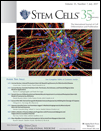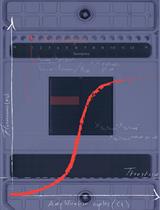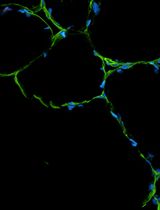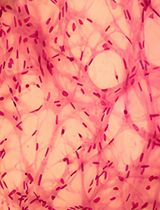- EN - English
- CN - 中文
Mouse Satellite Cell Isolation and Transplantation
小鼠卫星细胞的分离和移植
(*contributed equally to this work) 发布: 2018年01月20日第8卷第2期 DOI: 10.21769/BioProtoc.2696 浏览次数: 11374
评审: Beatriz CastroAnonymous reviewer(s)
Abstract
Satellite cell (SC) transplantation represents a powerful strategy to investigate SC biology during muscle regeneration. We described here a protocol for SC isolation from green fluorescent protein (GFP)-expressing mice and their transplantation into murine muscles. This procedure was originally used to assess the effects of the hormone unacylated ghrelin on muscle regeneration, in particular evaluating how the increase of unacylated ghrelin in the recipient muscle affected the engraftment of donor SCs (Reano et al., 2017).
Keywords: Satellite cells (卫星细胞)Background
Skeletal muscle, which is composed of differentiated myofibers, can regenerate upon injury. Muscle regeneration relies on a population of quiescent resident stem cells called satellite cells (SCs) that reside beneath the basal lamina of the muscle fiber (Mauro, 1961). Upon injury, SCs undergo activation, extensive proliferation, differentiation, and fusion, eventually repairing or replacing the damaged myofibers (Collins et al., 2005).
Transplantation of SCs was considered for many years a potential therapy for Duchenne Muscular Dystrophy (DMD), since the engrafted myoblast can fuse with host myoblasts, suggesting the possibility of a functional repair in defective fibers (Partridge et al., 1978). Unfortunately, in human clinical trials in DMD patients, this strategy failed to restore dystrophin in injected muscles, and no functional improvements have been observed (Partridge, 2002). Nevertheless, SCs transplantation still represents a robust strategy to investigate SC biology, mainly to study both cell-autonomous and non-cell-autonomous mechanisms of muscle regeneration. In this protocol, we describe a method to transplant cells isolated from GFP-expressing donor mice that allow an easy tracking and measurement of engrafted cells in the recipient muscles. We used a simple and relatively inexpensive cell isolation method; however, cells to be transplanted can be isolated by different techniques, such as Fluorescence Activated Cell Sorting (FACS) or magnetic beads.
Materials and Reagents
- 0.2 µm microfilters (VWR, catalog number: 28145-475 )
- Disposable sterile plastics:
- 15 ml conical tubes
- 100 mm Petri dishes
- 10 ml conical tubes
- 5 ml serological pipettes
- 10 ml serological pipettes
- 1.5 ml microcentrifuge tubes
- 20 to 1,000 µl pipette tips
- 10 ml plastic syringes (Terumo Medical, catalog number: SS-10L )
- 15 ml conical tubes
- Surgical blades (Moretti S.p.a.–Chimo)
- 40 µm cell-strainer (Corning, catalog number: 431750 )
- Adhesion microscope slides Superfrost Ultraplus (Thermo Fisher Scientific, Thermo ScientificTM, catalog number: J3800AMNZ )
- 22 x 22 mm slide cover glasses (Bio-Optica, catalog number: 09-02222 )
- Feather microtome C35 blades (PFM Medical, catalog number: 207500003 )
- Blotting paper for general purpose
- 10 week-old C57BL/6-Tg(CAG-EGFP)131Osb/LeySopJ mice (GFP mice), as donor mice (THE JACKSON LABORATORY, catalog number: 006567 )
- 4 month-old C57BL/6J, as recipient mice (THE JACKSON LABORATORY, catalog number: 000664 )
- Isofluorane (Isofluorane-vet, Merial Italia, catalog number: 00018152 )
- Ethanol (Honeywell International, catalog number: 458600 )
- Liquid nitrogen
- Cryostat embedding medium, Killik (Bio-Optica, catalog number: 05-9801 )
- Bovine serum albumin (BSA) (Sigma-Aldrich, catalog number: A2153 )
- Triton X-100 (Sigma-Aldrich, catalog number: T9284 )
- Rabbit anti-green fluorescent protein (GFP) antibody (Thermo Fisher Scientific, Invitrogen, catalog number: A-11122 )
- Donkey anti-rabbit IgG (H+L) Alexa Fluor 488 conjugate (Thermo Fisher Scientific, Invitrogen, catalog number: A-21206 )
- 4’,6-Diamidino-2-phenylindole, dihydrochloride (DAPI) (Thermo Fisher Scientific, InvitrogenTM, catalog number: D1306 )
- Slow-fade, glycerol-based mounting medium (Thermo Fisher Scientific, InvitrogenTM, catalog number: S36936 )
- Paraformaldehyde (PFA) (Sigma-Aldrich, catalog number: P6148 )
- Sucrose (Sigma-Aldrich, catalog number: S0389 )
- Cardiotoxin (CTX) from Naja pallida (Latoxan, catalog number: L8102 )
- 0.9% NaCl (Sigma-Aldrich, catalog number: S8776 )
- Sodium chloride (NaCl) (Sigma-Aldrich, catalog number: S3014 )
- Potassium chloride (KCl) (Sigma-Aldrich, catalog number: P9333 )
- Sodium phosphate dibasic (Na2HPO4) (Sigma-Aldrich, catalog number: 255793 )
- Potassium phosphate monobasic (KH2PO4) (Sigma-Aldrich, catalog number: P5655 )
- Pronase from Streptomyces griseus (Sigma-Aldrich, Roche Diagnostics, catalog number: 10165921001 )
- DMEM–Dulbecco’s Modified Eagle Medium, high glucose (Thermo Fisher Scientific, GibcoTM, catalog number: 11965092 ) supplemented (for all procedures) with antibiotic-antimycotic solution (Sigma-Aldrich, catalog number: A5955 )
- Donor horse serum (HS) (Thermo Fisher Scientific, GibcoTM, catalog number: 16050130 )
- Fetal bovine serum, FBS (Thermo Fisher Scientific, GibcoTM, catalog number: 10270 )
- 2-Methylbutane (AKA Isopentane) (Sigma-Aldrich, catalog number: 277258 )
- Ethanol working solution (see Recipes)
- Paraformaldehyde (PFA) working solution (see Recipes)
- Sucrose working solutions (see Recipes)
- Cardiotoxin (CTX) 50 µM stock solution (see Recipes)
- Sterile phosphate-buffered saline (PBS) (see Recipes)
- 0.1% (1 mg/ml) pronase solution in serum-free DMEM (see Recipes)
- Media (see Recipes)
- 10% HS in DMEM
- 20% FBS in DMEM
- 10% HS in DMEM
Equipment
- 20 to 1,000 µl precision micropipettes
- Pipet controller
- Gas anesthesia systems: Isofluorane vaporizer, oxygen concentrator, flowmeter, induction chamber and gas mask (2B–2biological Instruments)
- Tissue culture laminar flow hood
- Surgical instruments:
- Hamilton repeating dispenser, composed by the assembly of the three components shown in Figure 1:
- Hypodermic needle G30, 0.30 x 12.7 mm (PIC solution, catalog number: 03070300300.800 )
- Hamilton 50 μl 1705 LT syringe (Hamilton, catalog number: 80901 )
- PB600-1 repeating dispenser (Hamilton, catalog number: 83700 )
- Hypodermic needle G30, 0.30 x 12.7 mm (PIC solution, catalog number: 03070300300.800 )
- 37 °C orbital shaker
- Centrifuge (we used a Beckman Coulter, model: Allegra X-22R centrifuge with SX4250 (Beckman Coulter, model: SX4250 ) and F2402H (Beckman Coulter, model: F2402H ) rotors for 15 ml and microcentrifuge tubes, respectively)
- Incubator for cell culture
- Hemocytometer chamber (Burker chamber or similar)
- Pannoramic Midi II automatic digital slide scanner (3DHISTECH, model: Pannoramic MIDI II )
- Fluorescence microscope/fluorescence slide scanner
- Confocal microscope (we used the Leica Microsystems, model: Leica TCS SP2 )
- Analytical balance
- Cryostat (we used the Leica Microsystems, model: Leica CM1850 UV )
- Autoclave

Figure 1. Components to assemble a Hamilton repeating dispenser: hypodermic needle (A), Hamilton syringe (B), and repeating dispenser (C)
Software
- Image processing software such as ImageJ (https://imagej.net/)
- SPSS v17.0 software for Windows (SPSS; Chicago, IL)
Procedure
文章信息
版权信息
© 2018 The Authors; exclusive licensee Bio-protocol LLC.
如何引用
Angelino, E., Reano, S., Ferrara, M., Agosti, E., Sustova, H., Malacarne, V., Clerici, S., Graziani, A. and Filigheddu, N. (2018). Mouse Satellite Cell Isolation and Transplantation. Bio-protocol 8(2): e2696. DOI: 10.21769/BioProtoc.2696.
分类
干细胞 > 成体干细胞 > 肌肉干细胞
细胞生物学 > 细胞移植 > 同系移植
您对这篇实验方法有问题吗?
在此处发布您的问题,我们将邀请本文作者来回答。同时,我们会将您的问题发布到Bio-protocol Exchange,以便寻求社区成员的帮助。
Share
Bluesky
X
Copy link

















